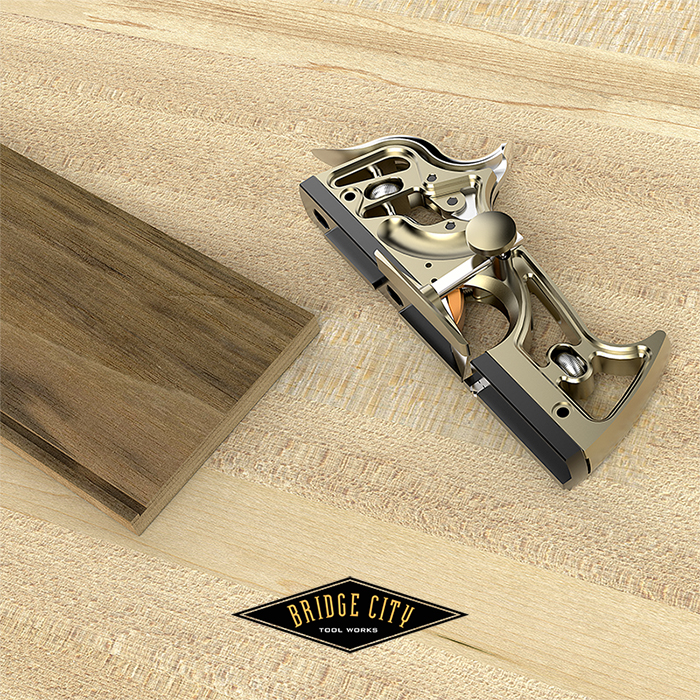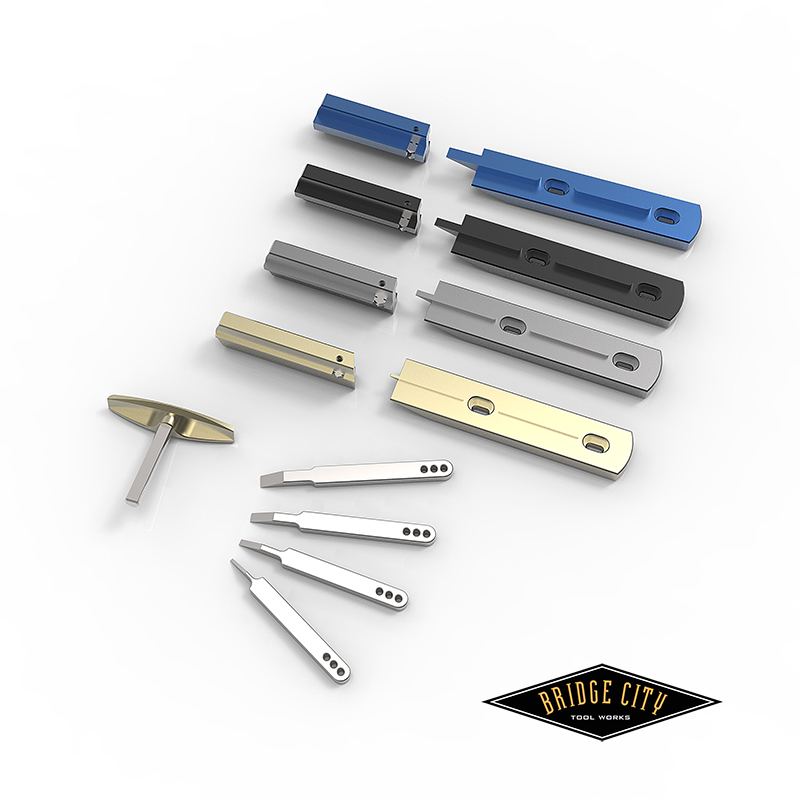Dear Drivel Starved Nation;
I have some really cool news regarding the Chopstick Master but I am going to save it until next week because it might get cooler…
I think the HP-10 Foxtail Convertible Plane is one of the best tools we have ever produced – it is a blast to use, fits the hand like a glove, and as of this writing, just got better.
Sometime next week, we will open up the pre-order window for the new Dado/Groove kits for this versatile plane. And for those of you with a pickled brain aging memory like me, grooves are cuts parallel to the grain and dado cuts are typically cut across the grain. A typical groove cut would be the cut in the sides of a drawer that receive the bottom as in the image below. A common dado cut is the cut across the grain to receive the ends of a bookshelf. This distinction is important because across the grain cuts require that the edges be scored or “nicked” before the plowing action of the iron engages. Without severing the cross grain fibers the cut looks like it was made with low grade explosives. Not good.
Here’s a pic of the new sole on the HP-10 and a walnut drawer side prior to cutting the dovetails;
We are making Dado/Grooves kits in the following widths; 1/16″, 1/8″, 3/16″ and 1/4″. The reasoning for these four sizes is simple, they are the most common for tongue and groove joints. The tongue counterparts for these four will be introduced in late December or early in January, 2016.
Here’s a peek at the complete kit, each size is a different color (anodized aluminum) so old farts like me can tell the difference;
The scoring cutters in these 4 sizes are unequaled in function. (For those of you with the HP-6 version, they are almost identical. They are little works of art and can easily be sharpened with a slip stone). With the grain, across the grain, end grain or diagonal, you will get razor crisp results that are smoother than what can be made with a saw or router. Oh, and a whole lot quieter too. The depth of the scoring cutter is adjusted by the retaining screws pictured above.
The little depth foot in the pic above fits in the bracket included with the Rabbet kit (everybody who owns the HP-10 has this bracket from the Rabbet Depth Stop). The foot and stem for the rabbet kit is too short for dado and groove cuts, hence this accessory.
Why is this important? Because not all grooves are for tongue and groove joints. Inlay strips, banding and other applications require a groove that is less deep and this stop will allow you to vary the groove/dado depths. Without the depth stop, all grooves/dados are as deep as they are wide — you simply cut until the plane quits cutting. Voila — a perfectly formed dado/groove.
Here’s another little cool detail. Each of these sole kits, regardless of the dado width, are exactly 1″ wide which means they are a tad wider than the plane body. Why? Because you can find the center line of your groove really easy if you know it is exactly 1/2″ from either of the sole edges. This is important when you need to use a shop made guide fence (strip of wood) to place your cut at odd angles or when the HP-10 Guide Fence runs out of travel.
Once you make a dado cut or a groove cut with this system you are going to have a hard time going back to that heavy, noise making router.
That’s it for now. Did I mention I have some really cool news regarding the Chopstick Master? I think I did big lie but can’t remember another big lie.
Thanks for reading this drivel,
-John
Bridge City Tool Works – Portland, OR



Nice! I was hoping that the dado/groove profiles were the next ones on the list. Having the large surface area of the HP-10’s handle will make plowing those dados a breeze! It could get a little onerous (not to mention painful) with the old HP-6v2.
Can hardly wait to hear about the Chopstick Master news. I was using my chopsticks last night, and it suddenly occurred to me that they’d make excellent Christmas presents. Given that I probably won’t have the tool in time to make a bunch of chopsticks for Christmas, I was going to send people pictures of the piece of wood, and tell them that this would – eventually – be their present. Hopefully they’ll be suitably thrilled.
And by the way, though I’ve been too preoccupied with this work thing, I’ve really been enjoying the blog posts of late – including (or perhaps especially) the insults. Always nice to be psychologically abused by your Tool Potentate.
— Peter
Peter,
Oh, you may be able to make chopsticks as gifts before this holiday season… use a little wishful thinking!
See ya later Bozo-
-John
Well that’s excellent news! Although I kind of liked the idea of sending people pictures of slabs of wood and telling them to be patient…
Not to cast aspersions on Bridge City’s stellar reputation for getting tools made exactly when predicted or anything, but I’m thinking it might take a LOT of wishful thinking. 😉
— Peter
Keep thinking positive thoughts – I stand by my response, except of course the reference to Bozo, that is just me being your abusive Tool Potentate.
Your Chopstick Master is actually en route to North America!
John:
Questions that have perplexed me:
1) Why with the dado attachments to tge HP-6 and HP-10 do you center the cutter on the plane body and not out to the side–that will align with the batton (a la a traditional dado plane, or the Stanley 39)? Registration against the fence would be easier….
2) I think I get why an iron can’t be skewed and function with this plane. Have you ever considered skewing the front end of the iron? I once saw someone on the Intertubes who’d done such surgery to a Stanley 45 or 55 iron (manufactured straight) with some success.
David-
1) I like centered profiles for several reasons, but the main reason is ease of use – I believe a centered profile on a narrow bodied plane is easier to use. I also like the that there is a sole surface on each side of the blade. And as you probably have noticed, I don’t pay that much attention to tradition, to my own detriment most of the time.
Let’s say you want to make a 3/8″ groove but our largest is 1/4″. Cut a strip of wood that is 1-1/8″ in width, center it on the centerline of your groove and clamp two guide strips adjacent to each edge. Remove the center board and run the plane 1/4″ dado/groove profile down one guide and then the other… Presto, 3/8″ groove. It is this ease that I like with centered profiles.
2) Can’t do skewed irons on this plane body. I have a couple of skewed iron planes in the works for 2016/2017.
Good questions, hope my answers help.
John
Hey, it is past “next week”… Where’s the rest of the cool news?
Yikes, the DSN is getting restless! I will post the news today!
-John
Will you be offering these in larger sizes eventually? The dado soles for the HP6 go up to 1/2″, and I would have thought you could go even larger on this body. The offerings you mention here seem sized for grooves rather than dadoes, which will require multiple cuts as your comment above describes.
Speaking of the HP6 … when will the dry spell end?
Thanks!
You asked a great question and the opportunity to answer by discussing plane design. Regarding depth of cut on the HP-10, keep in mind that the bed angle is 20 degrees (bevel up design). The bed angle on the HP-6 series of planes is 55 degrees (bevel down). This is an important consideration regarding our multi-plane body designs that fixed profile planes do not have to consider.
In both planes, as you create profiles that require a deeper cut, the mouth of the sole moves forward in a constant ratio in relation to the increase in depth. For example, the ratio on a 20 degree bed angle is almost 2.75:1 and on a 55 degree bed the ratio is approximately .7:1.
This means that on the HP-10, to increase the depth of the 1/4″ dado or tongue profiles to cut 1/2″ deep for example, the throat moves forward .687″ and actually falls under the nose portion of the plane. In short, it doesn’t work.
On the HP-6 however, we can increase the same depth of cut using the example above and the throat moves forward by .175″, a substantial distance difference.
I do plan on making wider tongue and groove profiles for the HP-10 but wanted to knock of the “low hanging” fruit first. I then plan on discussing the wider widths with the Drivel Starved Nation before we commit. The maximum depth of cut will still be around .250″
As for the HP-6, I have some new profiles that have yet to be released, and when we do, and if possible, I want to release the same profiles for those with the HP-10. 2016 is the short answer.
And if anybody is wondering if we plan on making a steeper bed angle foxtail plane, the short answer is no, not at least with the foxtail portion, a completely new design would be required. And I am getting older, faster it seems.
Thanks for asking.
-John
You mention bringing some of the upcoming HP-6 profiles to the HP-10, but what about some of the profiles the HP-6 already has? Any plans on bringing them over?
The HP-6 just became available again, and it’s tempting to pick it up, but I really love my HP-10 and would much prefer having them there.
–Jesse
We will duplicate many of the HP-6 profiles for the HP-10 but not all. The HP-10 has a .250 depth of cut limit.
John
Great to hear, thanks.
–Jesse